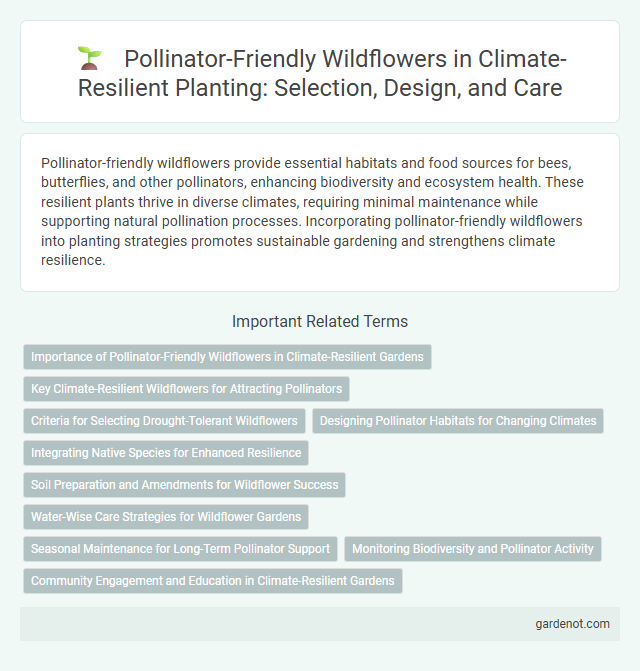Pollinator-friendly wildflowers provide essential habitats and food sources for bees, butterflies, and other pollinators, enhancing biodiversity and ecosystem health. These resilient plants thrive in diverse climates, requiring minimal maintenance while supporting natural pollination processes. Incorporating pollinator-friendly wildflowers into planting strategies promotes sustainable gardening and strengthens climate resilience.
Importance of Pollinator-Friendly Wildflowers in Climate-Resilient Gardens
Pollinator-friendly wildflowers play a crucial role in climate-resilient gardens by supporting essential pollinator populations like bees, butterflies, and hummingbirds, which enable plant reproduction and biodiversity. These wildflowers enhance ecosystem stability, improve soil health, and increase garden resilience against climate stressors such as drought and extreme temperatures. Incorporating native, pollen-rich wildflower species maximizes habitat value, promotes pollinator diversity, and sustains food webs critical for long-term environmental balance.
Key Climate-Resilient Wildflowers for Attracting Pollinators
Key climate-resilient wildflowers such as purple coneflower (Echinacea purpurea), black-eyed Susan (Rudbeckia hirta), and bee balm (Monarda fistulosa) play a vital role in supporting pollinator populations by providing robust nectar sources even under extreme weather conditions. These native species exhibit drought tolerance and adaptability to poor soils, ensuring sustained pollinator activity during climate stress. Incorporating these wildflowers into planting schemes enhances ecosystem stability by promoting biodiversity and aiding the survival of essential pollinators like bees, butterflies, and hummingbirds.
Criteria for Selecting Drought-Tolerant Wildflowers
Selecting drought-tolerant wildflowers for pollinator-friendly planting requires evaluating their ability to thrive in low-water conditions while providing nectar and pollen resources. Key criteria include deep root systems for water absorption, bloom periods that align with pollinator activity, and native species adaptation to regional climates. Prioritizing wildflowers such as Echinacea purpurea, Gaillardia, and Coreopsis ensures resilience during dry spells and sustained support for bees, butterflies, and other pollinators.
Designing Pollinator Habitats for Changing Climates
Designing pollinator-friendly wildflower habitats involves selecting native plant species that bloom at different times to ensure continuous nectar availability, supporting diverse pollinator populations throughout changing seasons. Incorporating drought-resistant and climate-adaptive wildflowers enhances resilience against temperature fluctuations and irregular rainfall patterns, crucial for sustaining pollinator health. Strategic habitat placement, considering microclimates and connectivity to existing green spaces, maximizes foraging efficiency and promotes genetic diversity among pollinator communities.
Integrating Native Species for Enhanced Resilience
Incorporating native pollinator-friendly wildflowers into climate-resilient planting strategies enhances ecosystem stability by supporting local bee and butterfly populations essential for pollination services. Native species such as Echinacea purpurea and Asclepias tuberosa are adapted to regional climate conditions, improving survival rates and reducing maintenance needs. This integration promotes biodiversity, strengthens habitat connectivity, and contributes to the resilience of both natural and agricultural landscapes under changing climatic conditions.
Soil Preparation and Amendments for Wildflower Success
Optimal soil preparation for pollinator-friendly wildflower planting involves testing soil pH and nutrient levels to ensure a balanced growing environment. Incorporating organic amendments such as compost or well-rotted manure enhances soil structure, moisture retention, and fertility, promoting robust root development. Avoiding excessive nitrogen-rich fertilizers prevents dominant weeds, allowing wildflowers to thrive and support diverse pollinator populations effectively.
Water-Wise Care Strategies for Wildflower Gardens
Pollinator-friendly wildflower gardens thrive with water-wise care strategies that include deep, infrequent watering to encourage drought-tolerant root systems and soil moisture retention. Utilizing mulch reduces evaporation and suppresses weeds, conserving water while protecting plant health. Selecting native wildflower species adapted to local climates optimizes resilience against water scarcity and supports essential pollinator populations.
Seasonal Maintenance for Long-Term Pollinator Support
Pollinator-friendly wildflower gardens require seasonal maintenance to ensure continuous nectar and habitat availability, supporting long-term pollinator health. Regular practices such as early spring pruning, timely deadheading, and strategic reseeding encourage vibrant blooms and diverse plant succession throughout the growing seasons. Monitoring and adjusting soil conditions, combined with invasive species control, further enhance the resilience and sustainability of pollinator habitats in changing climatic conditions.
Monitoring Biodiversity and Pollinator Activity
Pollinator-friendly wildflower planting enhances ecosystem resilience by supporting diverse pollinator species essential for crop productivity and ecological balance. Monitoring biodiversity through regular surveys of pollinator activity provides critical data to assess habitat quality and inform adaptive management strategies. Integration of sensor technology and citizen science platforms improves real-time tracking of pollinator populations, enabling targeted interventions to sustain pollinator health in climate-resilient landscapes.
Community Engagement and Education in Climate-Resilient Gardens
Pollinator-friendly wildflower gardens enhance climate resilience by supporting biodiversity and improving ecosystem stability. Community engagement programs teach local residents about the crucial role of pollinators in maintaining plant health and food security under changing climate conditions. Educational workshops and volunteer planting events foster stewardship and collective action, driving long-term conservation efforts in urban and rural landscapes.
Pollinator-friendly wildflower Infographic

 gardenot.com
gardenot.com